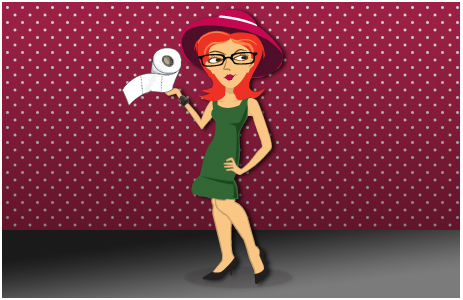Send your question to Umbra!
Q. Dear Umbra,
Is it more environmentally sound to throw tissue paper in the toilet or in the trash?
I’m disturbed by how much toilet paper is used by one family alone and wonder just what it takes to remove all that paper from the sewage system and from the waste stream. I would really appreciate your advice about the best way to dispose of tissue paper.
L.S.
Mill Valley, Calif.
A. Dearest L.S.,
Oh, bathroom quandaries — they perplex my readers and force me to employ no end of euphemisms.
I’m going to assume from your letter that you’re on a sewer line rather than a septic tank. And L.S., I have good news: it is no one’s job to pick out your toilet paper from the sewage system. Here’s a quick rundown of what happens once you flush: At treatment plants, bacteria processes the, um, organic matter and breaks down the toilet paper fiber. This process does release CO2; however, if you were to toss your toilet paper in the trash, the landfill decomposition process would produce methane — a far more harmful greenhouse gas than CO2.
However, in order to break down any solids that settle out of the waste water, many sewage treatment plants use a process that also produces methane. But (and we have so many buts here, don’t we) according to a story in The Economist, this methane can be harnessed for heating and generating electricity, and groups like British utility company GENeco are testing ways to make the whole process more efficient. So environmentally speaking, it’s not a super-easy call, but I say flush.
And sanitarily speaking, if I may, flushing is definitely the way to go. Just make sure you have a low-flow toilet — and don’t discount the “let it mellow” rule.
L.S., if toilet paper consumption is your real beef — Americans use an average of 57 sheets of toilet paper per day, about 50 pounds per year — might I suggest you use less, fold rather than scrunch to increase usable surface area, or change your product. Switch from the cloud-like comfort of conventional TP to recycled toilet paper, and you’ll be saving trees with every pee.
Softly,
Umbra
Q. Dear Umbra,
I want to avoid harsh chemicals, so I don’t use dryer sheets. I bought those plastic spiky dryer balls to use in the dryer but wonder if I am substituting dryer sheet chemicals for plastic chemicals on my clothes. P.S. I know I should hang my clothes outside, but my neighborhood bans clotheslines.
Thanks!
Alice S.
Prescott, Ariz.
A. Dearest Alice,
Props to you for breaking the dryer sheet cycle. But I’m afraid your balls probably aren’t the best alternative. Most dryer balls are made from PVC, which is damaging to the environment and your health. Remember: “No PVC for me.” And beware of companies touting products made of “safe plastic” without telling you what these plastics are (check out my previous column on plastics to avoid for the real skinny).
In the name of less consumption, ask yourself: Do I really need a dryer sheet replacement? What exactly do you want from these balls? Fluffing, softening, reducing static? Natural-fiber clothing typically doesn’t create much static electricity in the dryer, and you can soften clothes with natural alternatives: While you’re washing, try adding a half-cup of baking soda during the rinse cycle or white vinegar during the wash cycle.
If you still want to give the balls a go in the name of fluffing and potentially reducing drying time, opt for wool dryer balls or, if you’re feeling crafty, try making your own.
Finally, you beat me to the punch on suggesting a clothesline, but might I recommend an indoor drying rack — or a combo: Toss your clothes in the dryer until they’re mostly dry, and then hang them on the rack, simultaneously reducing static cling and your energy usage.
Freshly,
Umbra
Q. Dear Umbra,
Tried to find you on Twitter; couldn’t find you?
Lisa
A. Dearest Lisa,
How I loathe being unable to find something. Just the other day I was looking everywhere for my glasses, until I suddenly realized they were right here on my face. And much like my glasses were exactly where one would expect them to be, my Twitter account is much where you would expect it to be — in the Twittersphere. You can follow me @AskUmbra.
Chirpily,
Umbra

